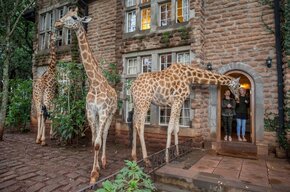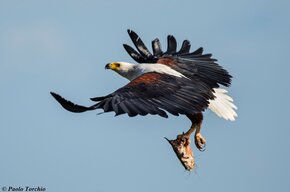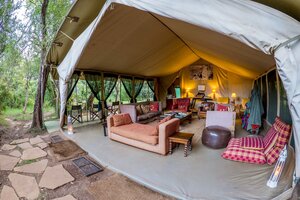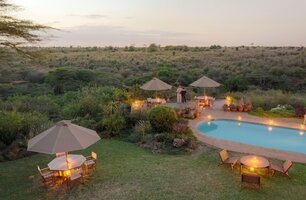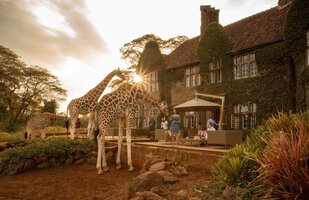Overview
Nairobi National Park lies within sight of Nairobi city, and animals can be seen against a backdrop of high-rise buildings. The park’s proximity to a large urban center is unique in Africa and wildlife viewing is surprisingly good. Most big safari animals are present (except elephants). There is a small walk at the entrance leading through indigenous forest, and several wildlife enclosures. As a successful rhino sanctuary, the park has an excellent record for supporting the species and nurturing them until they are re-located to their former range and to other upcoming sanctuaries. Due to this success, it is one of the few parks where a visitor can be certain of seeing a black rhino in its natural environment. Nairobi National Park is a 117 km2 area including a diverse range of habitats with a wealth of flora and fauna. There are vast tracts of open grass plains with scattered acacia bush. There is a highland dry forest on the western side of the park and to the south there is riverine forest and a permanent river. There are also stretches of broken bush and deep, rocky valleys and gorges with scrub and long grass. Further environments have been created by man-made dams and these have attracted certain species of birds and aquatic life. During the dry season the dams also attract water-dependent herbivores. Nairobi National Park has over 400 species of bird (some are seasonal). Northern migrants pass through the park primarily during late March through April.Why Go:
- Good wildlife viewing with most safari animals present
- Easy day or half-day trip from Nairobi
- Interesting photo possibilities with animals against city backdrop
- Safari boardwalk with unusual animals, including bongo antelope
- Animal orphanage
- High density of black rhino
Wildlife
Nairobi NP has a decent variety of wildlife. Aside from elephants, all of the Big Five are present. There is a good population of both black and white rhino and the latter are often seen grazing on the open plains. Leopards are shy, but lion, cheetah and hyena are regularly spotted. In July and August, a mini migration of wildebeest, zebra and gazelle crosses into the park from the surrounding areas.
More About the WildlifeScenery
Most of Nairobi National Park consists of open grassland. The city’s high-rise buildings are visible and, from a wilderness point of view, are quite disturbing – although it does create opportunities for unusual pictures. The Athi river track in the south of the park offers views over the scenic waterway, ridge and cliffs. The safari walk at the entrance of the park meanders through a beautiful patch of indigenous forest.
Best Time to Visit
Visitors will be treated to dust-free skies and an abundance of baby animals and migratory birds during the wettest period of the year (March to May). However, the wildlife will be harder to track down and driving conditions will be testing, to say the least. Your best bets for animal spotting are the other months of the year, which are drier and sunnier.
More About the Best Time to VisitWeather & Climate
The weather is predictable at Nairobi National Park as it adheres to longstanding climatic patterns. The Dry season (June to October) is marked by an absence of rain and loads of sunshine. The Wet season (November to May) has two periods of rain (November to December, and March to May), with an intervening period of drier weather. The park’s high altitude means cool air is the norm at night.
More About the Weather and ClimateWildlife & Animals
Nairobi National Park has a good variety of wildlife. Apart from elephants, most big safari animals are present. There is a very good chance of seeing rhino. White rhino are easiest to spot as they graze on the open plains, but the park is one of Kenya’s most successful sanctuaries for black rhino, which like to keep hidden in the thickets.
Elephant
None
Giraffe
Common
Hippo
Occasional
Buffalo
Occasional
Zebra
Common
Wildebeest
Common
Lion
Occasional
Leopard
Rare
Cheetah
Rare
Hyena
Occasional
Wild Dog
None
Black Rhino
Rare
White Rhino
Occasional
Wildlife highlights
Lion, cheetah, Masai giraffe and buffalo are just some of the animals you can encounter on a half-day trip in Nairobi NP. It is also a good place to see some of the more unusual antelope species including oribi, a grassland special. Coke's hartebeest is quite common and if lucky, a herd of shy eland will come into view. Pairs of little kirk's dik-dik can be spotted as well.Best time for wildlife viewing
The best time to visit Nairobi National Park is in the Dry season (from June to September) when animals gather around remaining water sources, although it can be visited throughout the year. The long rains (March to May) and short rains (October to November) usually make animal spotting more difficult. Rain can interfere with your game drive and the vegetation tends to be very high.Best Time to Visit
- June to September (Little to no rainfall)
- December to March and July to October (Busy)
- 117km² / 45mi²
- 1,511-1,754m / 1,040-2,589ft
Little to no rainfall
June to September is best for general wildlife viewing
December to March and July to October
The park can get quite busy
April to June
Little to no rainfall
April, May and November
Wettest months
June to February
- Dry Season- Sunny and dry aside from the short rains around November
- The grass is short and animals congregate around water sources
- Animals from surrounding areas are attracted to water sources in the park
March to May
- Wet Season- Skies are clear of dust, the park is green, and there are lots of flowers
- There are many newborn animals
- Bird watching is excellent and migratory birds are present
Weather & Climate
Nairobi has a cool and temperate climate. Temperatures are reasonably constant year-round, and it cools off considerably at night. There is very little rain in the Dry season between June and October. November to May, the Wet season, has two periods of rain. The ‘short rains’ are heaviest in November, and the ‘long rains’ are at their peak in April.Climate Chart
- 1,511-1,754m / 4,957-5,755ftDry season
- June to OctoberIt rains very little in the Dry season, although when the first rains fall is changeable. July and August are the coolest months, and temperatures increase in September through October before the rain breaks.
- June, July, August & September Lots of sunshine with very little rain. Afternoons are pleasant with temperatures around 24°C/75°F, but evenings and early mornings are cold with temperatures of around 12°C/54°F.
- October It is warming up a bit with afternoon temperatures of about 26°C/79°F. The short rains might start towards the end of the month, or it might be later in November. Temperatures drop after the rains.
Wet season
- November to MayThe Wet season is comprised of three distinct parts: the 'short rains' from November to December and the 'long rains' from March to May, with a dry period separating them.
- November & December 'Short rains': October or November sees the start of the short rains, which normally peak in November. Temperatures increase before it rains, drop immediately after, and average at 25°C/77°F in the afternoon.
- January & February The rains dry up in these months, separating the two rainy seasons. It’s the hottest time of year with average afternoon temperatures of 28°C/82°F.
- March, April & May 'Long rains': April is the wettest month and rain might interfere with your game drives. Road conditions deteriorate. The rain diminishes in May, but the roads may still be problematic until later that month. Afternoon temperatures are around 26°C/79°F.

